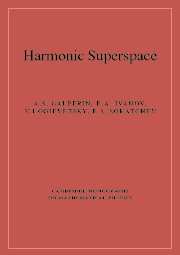Book contents
- Frontmatter
- Contents
- Preface
- 1 Introductory overview
- 2 Elements of supersymmetry
- 3 Superspace
- 4 Harmonic analysis
- 5 N = 2 matter with infinite sets of auxiliary fields
- 6 N = 2 matter multiplets with a finite number of auxiliary fields. N = 2 duality transformations
- 7 Supersymmetric Yang–Mills theories
- 8 Harmonic supergraphs
- 9 Conformal invariance in N = 2 harmonic superspace
- 10 Supergravity
- 11 Hyper-Kähler geometry in harmonic space
- 12 N = 3 supersymmetric Yang–Mills theory
- 13 Conclusions
- Appendix: Notations, conventions and useful formulas
- References
- Index
13 - Conclusions
Published online by Cambridge University Press: 24 August 2009
- Frontmatter
- Contents
- Preface
- 1 Introductory overview
- 2 Elements of supersymmetry
- 3 Superspace
- 4 Harmonic analysis
- 5 N = 2 matter with infinite sets of auxiliary fields
- 6 N = 2 matter multiplets with a finite number of auxiliary fields. N = 2 duality transformations
- 7 Supersymmetric Yang–Mills theories
- 8 Harmonic supergraphs
- 9 Conformal invariance in N = 2 harmonic superspace
- 10 Supergravity
- 11 Hyper-Kähler geometry in harmonic space
- 12 N = 3 supersymmetric Yang–Mills theory
- 13 Conclusions
- Appendix: Notations, conventions and useful formulas
- References
- Index
Summary
We have presented the basics of the harmonic superspace approach but not the latest developments. Some of the most recent are mentioned in the Introduction as the motivation for writing this book. During the past few years this method has been advanced in several directions, some of which we briefly overview here.
Firstly, even at the early stages it was realized that higher N supersymmetries provide many more possibilities for choosing the harmonic superspaces and their analytic subspaces due to the higher rank of the relevant R symmetry groups. In [17] an exhaustive list of the coset spaces of such groups in terms of the corresponding harmonic variables was presented. No a priori reasons exist for preferring any of these higher N harmonic superspaces and the right choice is imposed by the problem at hand. For instance, as we have seen, the problem of constructing an off-shell formulation of N = 3 super Yang-Mills theory (which coincides with N = 4 SYM on shell) is solved using an N = 3 harmonic superspace based on the coset SU (3) / U (1) × U (1) [G5, G6]. Unfortunately, the analogous problem in N = 4 has not yet been solved. The only recent development has been the harmonic superspace (based upon the coset SU (4) / SU (2) × SU (2) × U (1)) reformulation of the on-shell constraints of N = 4 SYM proposed in [H19, H21].
- Type
- Chapter
- Information
- Harmonic Superspace , pp. 281 - 282Publisher: Cambridge University PressPrint publication year: 2001



